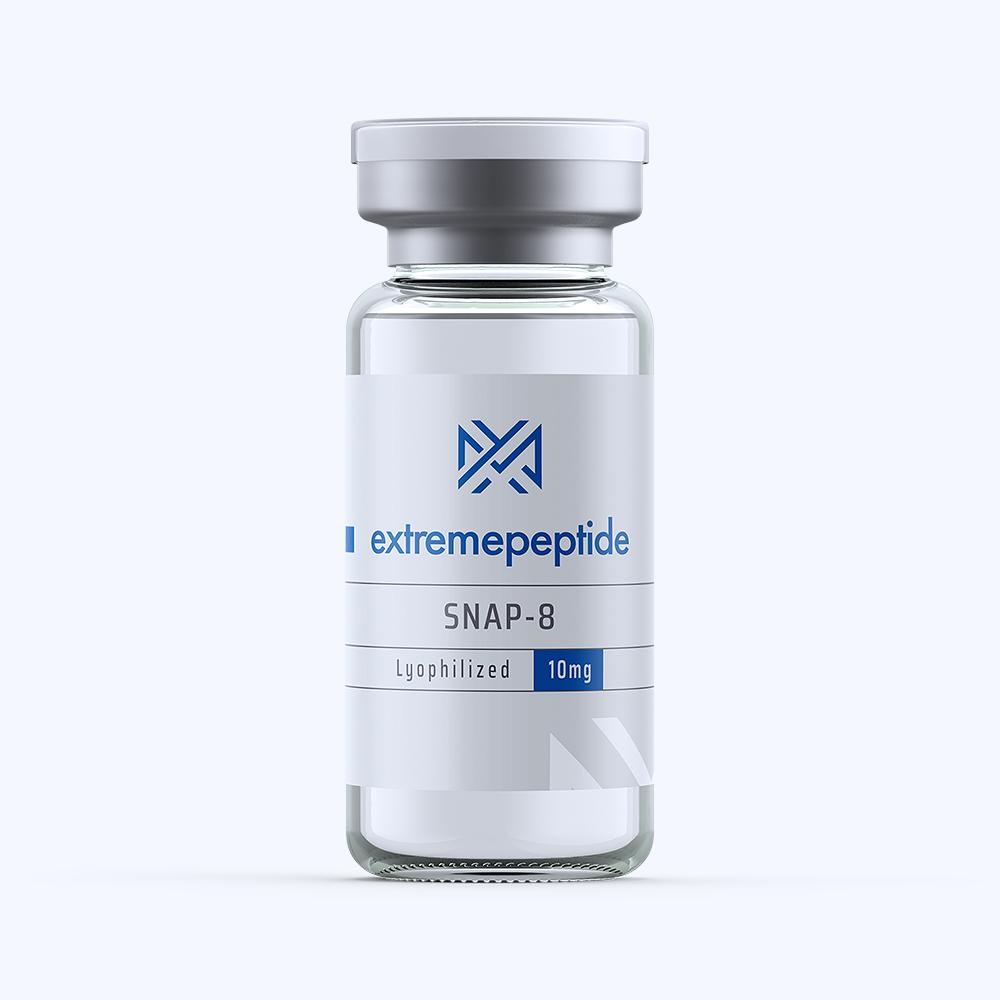Download or view the PDF version of this article by clicking here
Click here to view our entire peptide selection

SNAP-8 is a peptide whose full name is Synaptososomal-associated protein 25. As its name might suggest, the protein SNAP-8 is considered to be an octapeptide. This means that it is a protein fragment that is comprised of eight amino acids that are linked in a polypeptide chain. Its molecular formula is C14H70N16O16S, and it possesses a molecular weight of 1075.16. When it is used in conjunction with scientific study on animal test subjects, it typically has an appearance of a white powder, although it can also be administered to an animal test subject via a transparent solution. It has also been determined that it works best for scientific study when it is stored desiccated below -18 ° C, and that it should be stored at 4 ° C up to three weeks for future usage upon reconstitution. Typically, the shelf-life of the peptide is twelve months, but can be extended to up to eighteen months under the proper storage conditions.
Function of SNAP-8
Scientific study based on animal test subjects has determined that the primary function of SNAP-8 is to act as a muscle contraction inhibitor. This act of inhibition allows for muscles to achieve a more consistent level of homeostasis, as it allows for the neurotransmitters that are responsible that are responsible for bringing about homeostasis to be released on a much more efficient basis.
SNAP-8 and SNAP-25
According to scientific study that has been conducted on animal test subjects, it has been determined that SNAP-8 works in relation to the protein SNAP-25. Also known as Synaptosomal-associated protein 25, SNAP-25 is what is known as a t-SNARE protein. T-Snares are part of a large protein superfamily containing more than 60 members; in this case, it is proposed to account for the specificity of membrane fusion and to specifically carry out fusion by forming a tight complex that joins the synaptic vesicle and plasma membranes together.
Specifically, SNAP-25 is a membrane bound protein that is connected to the cytosolic face of membranes through the palmoitoyl side chains in the middle of the molecule. In other words, it the protein forms a covalent bond within the cell through its liquid matrix. It works to block P/Q and L-type voltage-gated calcium channels, which are groups of ion channels that possess permeability to the calcium ion Ca2+. The activation of these channels allows the ion to rush inside of the cell, which could produce various results depending on the cell type.
Some of the results include:
- The activation of calcium-sensitive potassium channels
- Excitation of neurons
- A boost in the regulation of gene expression
- The release of hormones
- The release of neurotransmitters
- Muscular contraction
In the case of muscles, SNAP-25’s ability to regulate muscular contraction through the activation of the Ca2+ ion allows animal test subjects to experience a level of homeostasis in terms of muscular contraction and ultimately muscular performance.
The downside to SNAP-25 is that when it becomes destabilized in the slightest, the cellular unit cannot release the proper neurotransmitters that would properly signal the activation of muscular contraction. As a result of this, the consistent level of muscular contraction is disrupted. When this degradation of performance occurs, the muscles respond by forming lines and wrinkles within animal test subjects. Scientific study that has been conducted on animal test subjects has noted that this physical reaction to the degradation is most prominent around the eyes and the face.
According to scientific study that has been based on animal test subjects, SNAP-8 functions by boosting the regulatory functions of the N-terminal end of SNAP-25. This elevation allows for the SNARE complex to stay stabilized, which in turn allows for SNAP-25 to remain stabilized for a significantly longer period of time. At the same time, SNAP-8 has been shown to inhibit the release of catecholamine, which is a general class of neurotransmitters that are derived from the amino acid tyrosine containing catechol and amine groups. This blockage also contributes to the stabilizing process in terms of the regulation of muscular contraction through the activation of the Ca2+ ion.
SNAP-8 and Acetyl hexapeptide-3
Scientific studies that have been based on animal test subjects have determined that the presence of SNAP-8 acts similarly to acetyl hexapeptide-3, which is a peptide that is derived from a fragment of SNAP-25. The two peptides differ in structure, as SNAP-8 is considered to be an octapeptide as opposed to a hexipeptide. Clinical studies on animal test subjects have determined that SNAP-8’s stabilizing functionality tends to work with more efficiency than its hexipeptide counterpart.
Click here to read SNAP-8 – Part 2
